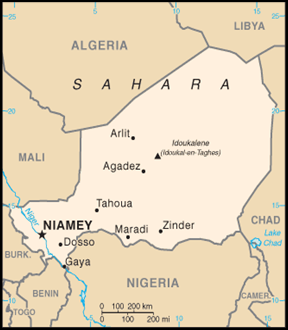Home » What We Do » Agriculture and Food Security » Food Assistance » Country Fact Sheets » Food Assistance Fact Sheet - Niger
- What We Do
- Agriculture and Food Security
- Democracy, Human Rights and Governance
- Economic Growth and Trade
- Education
- Ending Extreme Poverty
- Environment and Global Climate Change
- Gender Equality and Women's Empowerment
- Global Health
- Water and Sanitation
- Working in Crises and Conflict
- U.S. Global Development Lab

Map of Niger
October 6, 2017
Food Security Situation
- Structural vulnerabilities, including reliance on subsistence rain-fed agriculture with increasing rainfall variance and harsh climatic conditions, contribute to chronic food insecurity for the majority of households in Niger. Basic social services are especially limited in rural areas.
- In Niger’s Diffa region, ongoing Boko Haram-related conflict, an influx of Nigerian refugees, and internal population displacement have left local populations in a dire situation and highly food insecure. Additionally, land degradation, and climate change have exacerbated food insecurity and weakened the resilience of Diffa residents.
- According to the Famine Early Warning Systems Network (FEWS NET), most of Niger is expected to be in Minimal (IPC Phase 1)* food insecurity through September 2017 due to normal food availability. The pastoral zone and some agropastoral areas are expected to be in Stressed (IPC Phase 2) acute food insecurity due to the decline in animal prices and rising costs of animal care, diminishing household purchasing power. In the Diffa Region, Crisis (IPC Phase 3) acute food insecurity is expected to continue through September 2017 due to ongoing insecurity, which continues to negatively impact market access and humanitarian access.
*The Integrated Food Security Phase Classification (IPC) is a standardized tool that aims to classify the severity and magnitude of food insecurity. The IPC scale, which is comparable across countries, ranges from Minimal—IPC I—to Famine—IPC 5.
Response
- The Office of Food for Peace (FFP) partners with UN and non-governmental organizations to provide critical emergency food assistance to displaced Nigeriens, Nigerian and Malian refugees, and host communities affected by conflict through a combination of cash transfers, food vouchers, U.S. in-kind food aid, and local and regional procurement of food.
- FFP partners with the UN World Food Program (WFP) to provide assistance to chronically vulnerable communities across Niger to strengthen their capacity to cope with shocks, while ensuring a strong and flexible food and cash-based safety net. FFP also supports a joint project between the UN Food and Agriculture Organization and WFP, which implements seasonal livelihood programming, agricultural training, small-scale irrigation projects, and community-based planning. In light of persistently high acute malnutrition rates, FFP is also supporting the UN Children’s Fund to distribute locally procured therapeutic foods to children suffering from severe acute malnutrition.
- FFP supports three integrated development food assistance programs with Catholic Relief Services, Mercy Corps, and Save the Children to reduce food insecurity and malnutrition and to improve community resilience among rural households in the Maradi and Zinder regions. The programs target over 500,000 individuals and aim to promote positive behavior change in nutrition, health, hygiene, sanitation, and agriculture, as well as diversify livelihoods through livestock, savings and lending, and literacy activities.
Food for Peace Contributions
Total Contributions:
| U.S. Dollars | Metric Tons | |
|---|---|---|
| Fiscal Year 2017 | $58.7 million | 26,100 MT |
| Fiscal Year 2016 | $76.4 million | 27,524 MT |
| Fiscal Year 2015 | $69.2 million | 35,190 MT |
Fiscal Year 2017 Contribution Breakdown:
| U.S. Dollars | Metric Tons | |
|---|---|---|
| Title II Development | $35.7 million | 17,690 MT |
| Community Development Funds (CDF) | $8 million | -- |
| Title II Emergency | $15 million | 8,410 MT |
| Emergency Food Security Program (EFSP) | -- | -- |
Food Security Situation includes information from FEWS NET, WFP, and UNHCR
FY 2017 contribution based on funds obligated to date.







Comment
Make a general inquiry or suggest an improvement.